In the late spring of early May, my walks through the awakening riparian forest find an evolving carpet of green on the forest floor—mostly Virginia creeper and stinging nettle amid the underbrush of honeysuckle and elderberry. Virginia creeper, its bright green new leaves led by wandering tendrils looking for purchase, crawls the ground, over fallen logs, and up the stately trunks of Black Locust and Black Walnut trees. Within a few weeks, in the temporary open light as the trees still leaf-out, these tender young leaves form a moving sea of dark green over the entire forest floor, lapping up tree trunks like a high tide. Their woody vines and soft tendrils reach high and low. Dangling lianas drape down, entangle young trees and shrubs in a green mesh that reaches high into the tree canopy. It’s a veritable jungle.

Virginia creeper (Parthenocissus quinquefolia) is also called false grapes, woodbind, American ivy, five-leaf ivy, and thicket creeper. I personally like the ‘creeper’ part, given how this aggressive vine vigorously creeps over the ground, up trees, fence posts and buildings—pretty much any surface—to get into the light and flourish. It sends out tendrils with adhesive tips that allow the vine to attach to just about anything. This hardy salt-tolerant plant of the grape family will thrive in shade or sun and in most soil types.
Virginia creeper flowers in late spring with small barely noticeable buds that form green clusters.
I recently spotted Virginia Creeper vines flowering in the fall (October) as well; both buds and flowers took on a pinkish hue even as the leaves of the plant had gone a brilliant crimson and the plants were laden already with deep blue berries. These scarlet plants, draped over the side of the dam of the Otonabee River and feeling the fine spray of the spillway, were flowering again.

The flowers form in panicles or clusters with each 6 mm flower consisting of five greenish petals that curve backward, five stamens with white filaments and large yellowish anthers carrying pollen, and a pistil with a stout style. Sepals are pretty much absent. Illinois Wildflowers shares that the flowers on each plant may be perfect (with both pistil and stamen) or only staminate or only pistillate. I saw evidence of this in the fall flowers of the vine on the dam; many of the flowers were only pistillate.
The berries that form in late summer and fall are also green at first then ripen to blue-black, about the same colour as blueberries. The berries are highly toxic and can be fatal to humans. The sap also contains oxalate acid that may irritate the skin and cause a rash.


In the fall, the leaves turn a brilliant scarlet that turns dark to maroon or burgundy. The peduncles and pedicels of the flowers and berries that are initially green also turn a bright red.
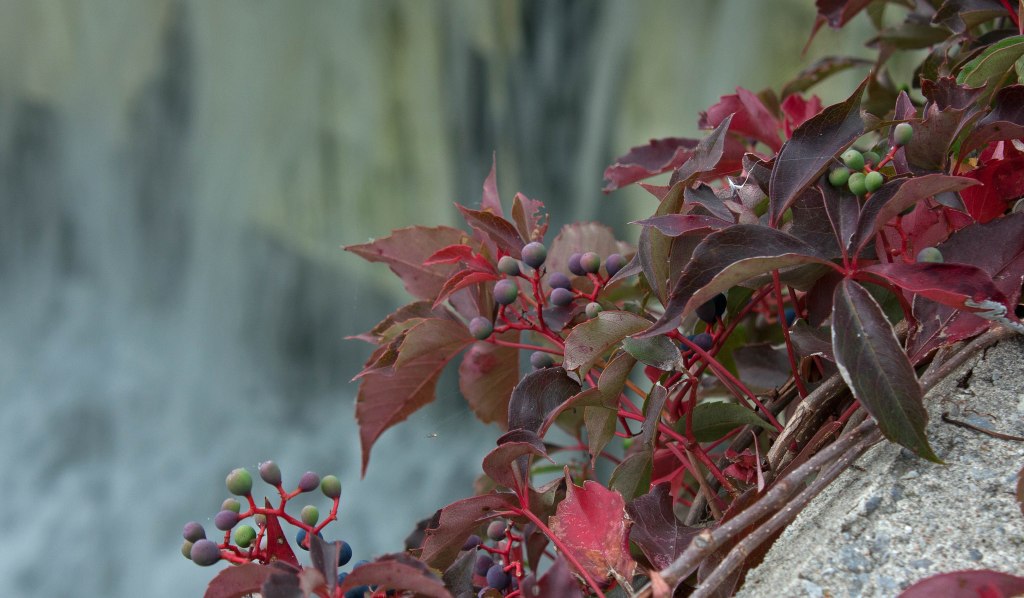
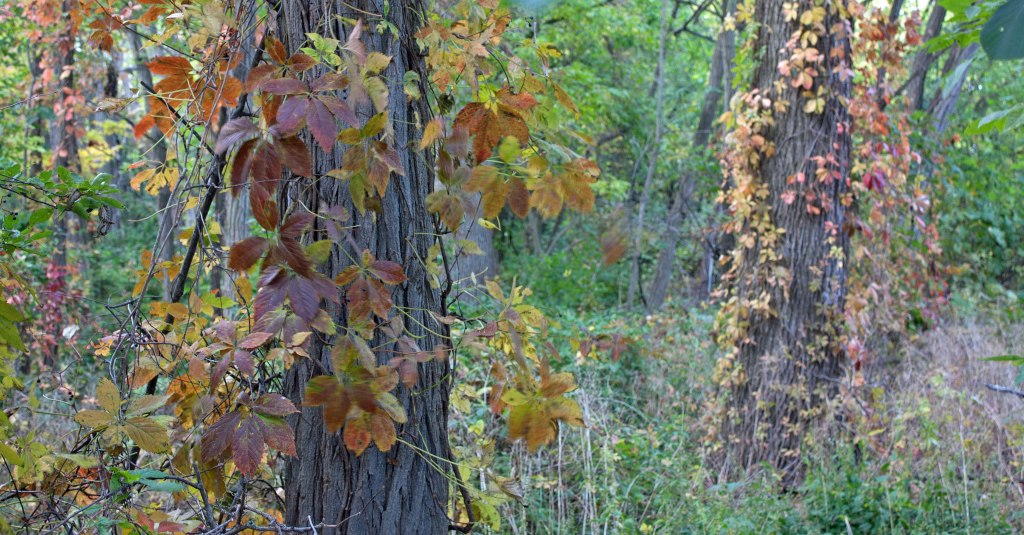
Unlike many of the other successful plants I’ve identified in the local riparian urban forest (e.g. dame’s rocket, Scilla siberica, Tatarian honeysuckle, common buckthorn, bull thistle, black locust, Phragmites) , Virginia creeper is not considered an invasive species. Virginia Creeper is native to Ontario and Quebec and keeps up very well amid invasives, earning it the title of “aggressive.”
Virginia Creeper and Allelopathy
Virginia creeper tends to grow where poison ivy grows—and they are often confused. This is because both can grow as vines and often inhabit disturbed areas. Young Virginia creeper leaves or those that have been damaged may occasionally have the telltale three leaflets of poison ivy instead of the usual five; poison ivy never has five leaflets: “leaves of three, let it be; leaves of five, let it thrive!”
But here’s the thing: In my many walks along the Rotary Trail and associated paths along the river, both places where Virginia creeper and poison ivy flourish, I’ve noticed that these two plants don’t mix. Wherever Virginia creeper has taken hold, there is no poison Ivy and vice versa—even if right next door. For instance, on a section of the Rotary Trail, one side is lined by Virginia creeper and the other side is guarded by poison ivy; as though they’d made some sort of pact: I have this side and you take the other side. As it turns out, this is not always the case; I’ve seen both all cozied up next to each other too. But it got me to wondering if Virginia creeper’s success may be partly due to its release of allelochemicals in a process called allelopathy.

Allelopathy is essentially the chemical inhibition of one species by another. This is accomplished through biochemicals that leach out of the plant to enhance survival and reproduction by inhibiting nearby competition. The allelopathic chemicals are usually released through a plant’s roots but they can also be released in other ways such as volatizing into the air from leaf surfaces) Allelochemicals can be present in any part of a plant: leaves, flowers, roots, fruits, or stems. They can also be found in the surrounding soil. All prevent the growth and reproduction of surrounding plants (particularly seed germination). Examples include black walnut, black locust, juniper, sumac, sugar maple, elderberry, cedar, blackberry, thistles, ragweed, purslane, and some ferns—among many others. Lettuce, for instance, is affected by thiocyanate, released by members of the cabbage family to discourage insect predation.
Ready to Adapt lists plants that tolerate juglone (the allelopathic chemical released by Black Walnut through roots into soil and leaves into the air) and Virginia creeper is on that list. That makes sense, given how Virginia creeper seems to adore this tree and its immediate environment.

In a forum on Gardenerscorner in the UK, I spotted a thread about how Virginia Creeper appeared to hamper the growth of another highly successful vine, Morning Glory. The gardener mentioned that the Morning Glory just stopped growing where it met the Virginia Creeper. It also stopped producing flowers.
In their masters thesis, published in 2018, Vit Kukolja with the Fisheries Research institute of Slovenia determined that, “allelopathic active ingredients of Virginia creeper in the soil [were exerted] in the immediate vicinity of the plant.”
Virginia Creeper Benefits to Wildlife
The University of Minnesota tells us that “Virginia creeper is extremely useful to wildlife. A variety of birds feed on the berries and many animals (squirrels, mice, deer, chipmunks, etc.) feed on the stems and leaves. The thick foliage provides shelter for wildlife. It is the larval host for several species of Sphinx moth: Abbotts Sphinx Moth (Sphecodina abbottii), Pandora Sphinx Moth (Eumorpha pandorus), Virginia Creeper Sphinx Moth (Darapsa myron), White-lined Sphinx Moth (Hyles lineata). Virginia creeper is used as a ground cover to prevent erosion. It contributes to the beautiful fall colors.” They add that the bark, leaves and roots have also been used in medicines.

Virginia Creeper Benefits to Humans & Medicinal Uses
Virginia creeper is grown as an ornamental plant, because of its ability to rapidly cover walls and buildings, and its colourful red to burgundy autumn foliage. The vine acts helps shade buildings on masonry walls. Virginia creeper acts as a decorative covering for walls, trellises, arbors and fences. It helps shade buildings on masonry walls and can be used to cover old stumps, rock piles and other ‘eyesores’. A pink dye is obtained from the fruit and a decoction of the leaves can be used as a black dye. Virginia creeper is also used for watershed protection and erosion control.
According to the Texas Parks & Wildlife, the Indigenous peoples use the plant as a tea for jaundice, root tea for gonorrhea and diarrhea, and leaf tea to wash swellings and as an astringent and diuretic. The twigs are used as a wash to counteract poison sumac and the plant also used as an herbal remedy for swelling, lockjaw and as a urinary aid.

According to Natural Medicinal Herbs, the bark and fresh young shoots act as an aperient, alterative, emetic, expectorant and a tonic. A hot decoction can be used as a poultice to help reduce swellings. Tea made from the leaves acts as an aperient, astringent and diuretic. In addition to helping against poison sumac, it is used as a wash on swellings and poison ivy rash.
Healthbenefitstimes lists additional uses and benefits of Virginia creeper:
- Bark as a tonic, expectorant, and remedy for dropsy
- Berries for rheumatic complaints and to help cure dropsy
- Bark and twigs used for cough syrup
- Fruit are useful in treating fevers and an infusion of fruit helps against rheumatic complaints and reported to cure dropsy
- Resinous matter from the bark of the main stems considered a useful stimulant and antispasmodic
- Leaves juice to cure headache, when applied to the nostrils
- An infusion of the leaves and berries will alleviate a severe headache
- Decoction of the leaves applied externally will destroy head lice in children
- Leaves have also been used as poultices and fomentations in glandular enlargements, indolent ulcers
I haven’t yet taken advantage of any of these benefits of the Virginia creeper. For now, I’m content to enjoy its beauty in my local riparian forest.


Nina Munteanu is a Canadian ecologist / limnologist and novelist. She is co-editor of Europa SF and currently teaches writing courses at George Brown College and the University of Toronto. Visit www.ninamunteanu.ca for the latest on her books. Nina’s bilingual “La natura dell’acqua / The Way of Water” was published by Mincione Edizioni in Rome. Her non-fiction book “Water Is…” by Pixl Press (Vancouver) was selected by Margaret Atwood in the New York Times ‘Year in Reading’ and was chosen as the 2017 Summer Read by Water Canada. Her novel “A Diary in the Age of Water” was released by Inanna Publications (Toronto) in June 2020.

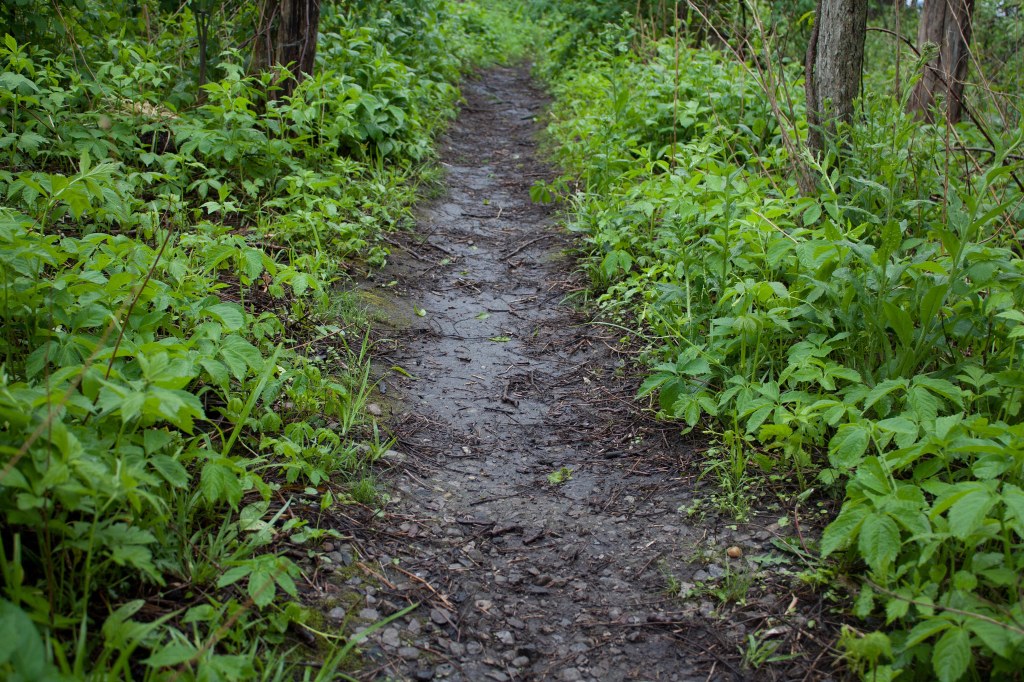
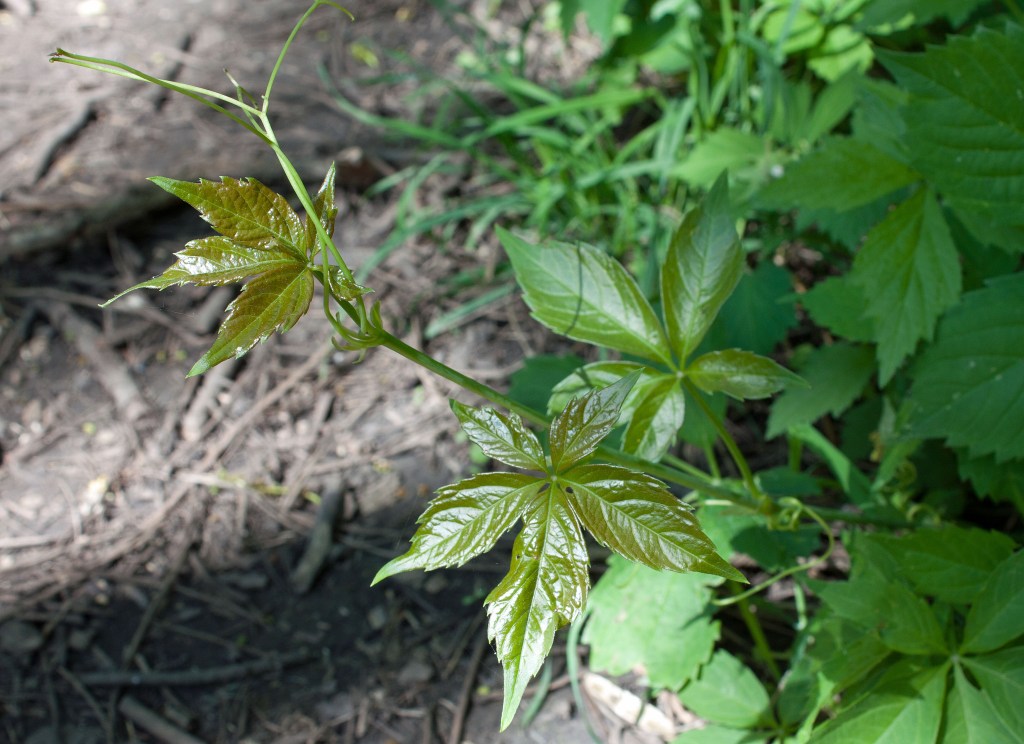





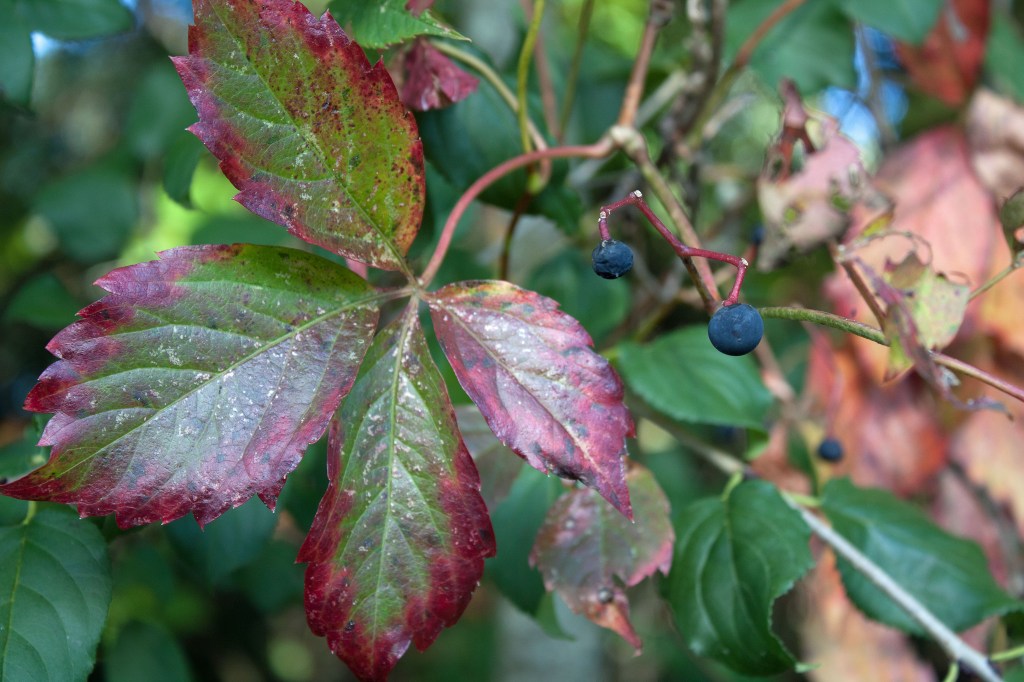
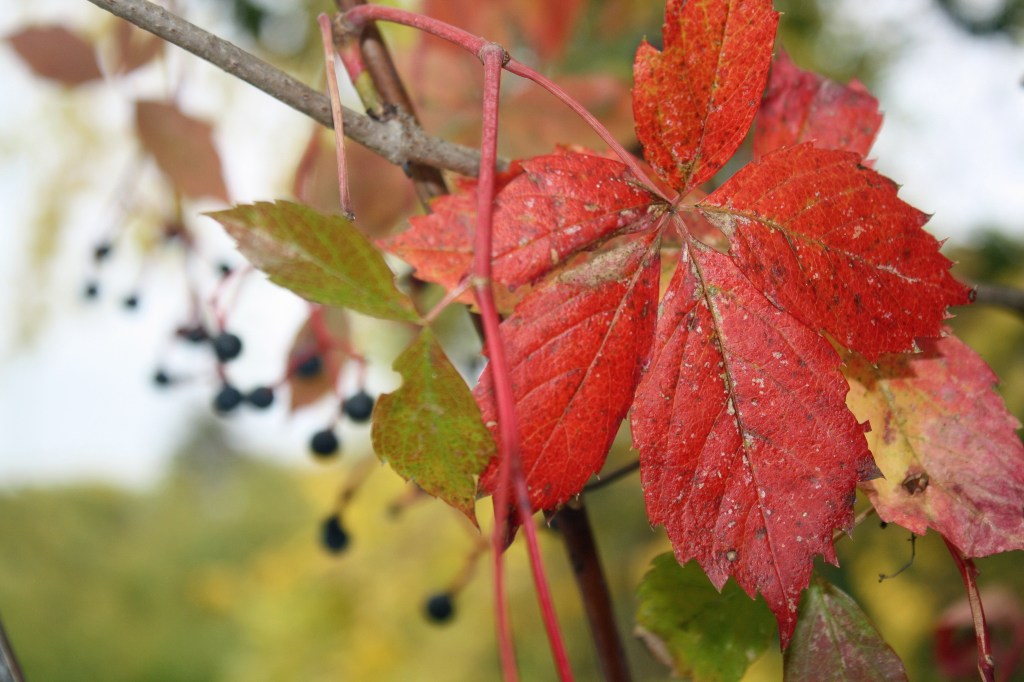

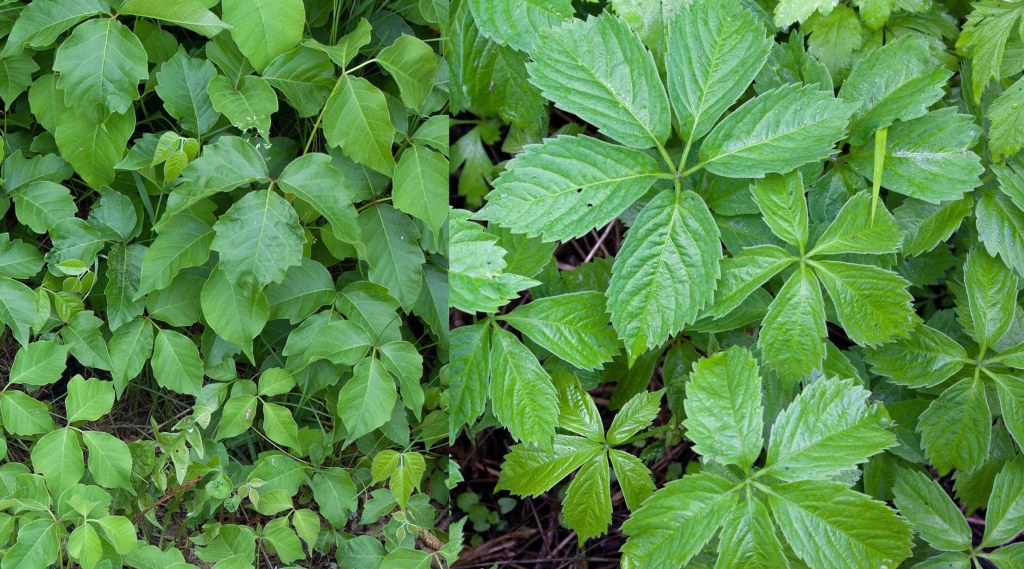

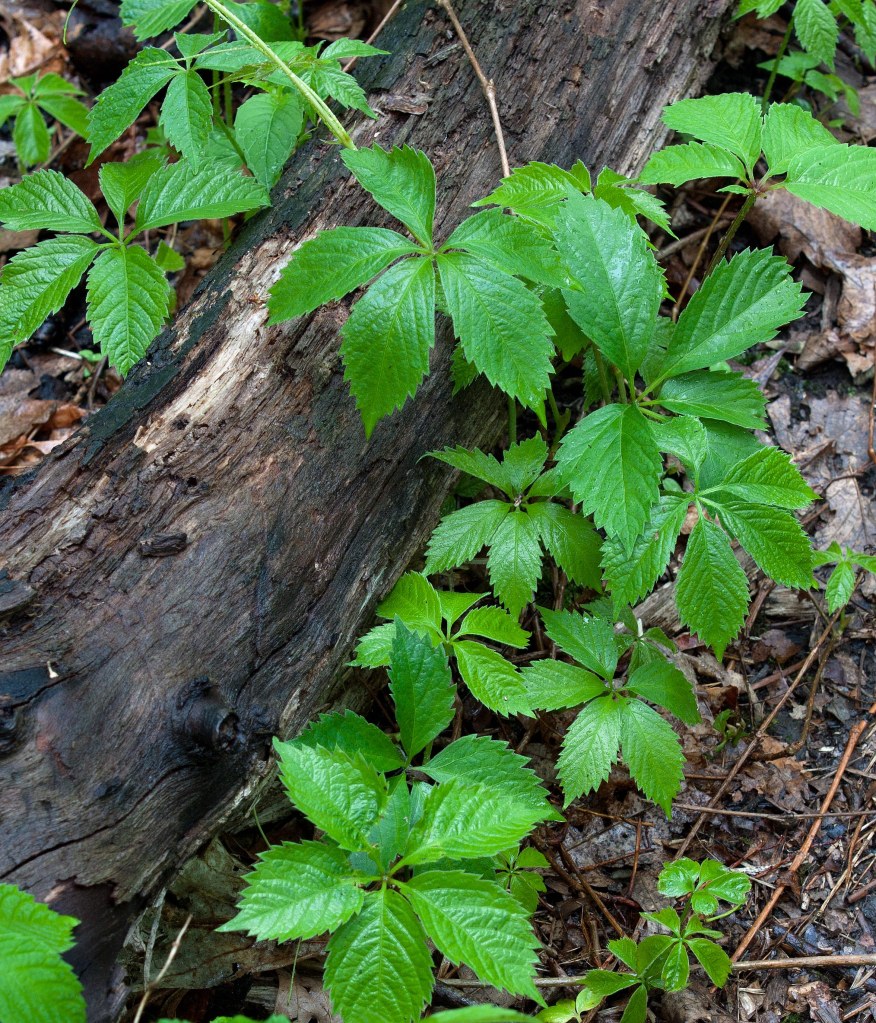

The Virginia Creeper seems a friendly plant — until it obscures your favourite woodland path! Even then, it is not much of a trip hazard. Watch for their red leaves in the fall.
LikeLiked by 1 person
Yes, it is indeed! And this highly spirited native holds its own very well against invasives! Thanks, Susan, for your comments. Nina
LikeLike